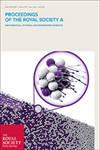材料性能和纤维形状对纤维复合材料中嵌入弹性基体的弹性纤维应力影响的有限元分析
Proceedings of the Royal Society of London. Series A. Mathematical and Physical Sciences
Pub Date : 2004-08-08
DOI:10.1098/rspa.2003.1264
引用次数: 39
摘要
采用有限元法计算嵌入弹性基体中的弹性纤维的轴向应力,对纤维复合材料进行建模。为嵌入在基体中的圆柱形、椭球形、抛物面和锥形纤维建立了轴对称模型,并以纤维轴向比q为特征。研究了q从200到1000的变化以及纤维与基体的杨氏模量Ef/Em的比值从50到104的变化对模型的影响。对于圆柱形纤维,所有q值和Ef/Em值沿纤维轴的轴向应力分布相似;它在中心处最大,在纤维长度的大部分稳步下降,在纤维末端附近迅速下降到零。对于固定q,应力的大小随Ef/Em的增加而增加,而对于固定Ef/Em,随q的变化很小。这些数据与以前的分析模型有很好的定性一致性。锥形纤维的轴向应力在纤维中心处最小,靠近纤维末端处逐渐增大至最大值。这在q值较小和Ef/Em值较大时最为明显。抛物面和椭球面的应力分布介于柱面和锥面之间。对于较小的Ef/Em值,所有形状的纤维和所有q值的轴向应力的大小和轴向分布几乎无法区分。本文章由计算机程序翻译,如有差异,请以英文原文为准。
Finite–element analysis of the effect of material properties and fibre shape on stresses in an elastic fibre embedded in an elastic matrix in a fibre–composite material
The finite–element method was used to calculate the axial stress in an elastic fibre embedded in an elastic matrix to model a fibre–composite material. Axisymmetric models were created for cylindrical, ellipsoidal, paraboloidal and conical fibres embedded in a matrix and characterized by a fibre axial ratio, q. The effects of varying q, from 200 to 1000, and the ratio of the Young moduli of the fibre and the matrix, Ef/Em, from 50 to 104, were investigated. For a cylindrical fibre, the axial stress distribution along the fibre axis was similar for all values of q and Ef/Em; it was greatest at the centre, decreased steadily over most of the fibre length and fell rapidly to zero near the fibre end. For fixed q, the magnitude of this stress increased with increasing Ef/Em, whereas for fixed Ef/Em the variation with q was small. There was good qualitative agreement between these data and previous analytical models. The axial stress in the conical fibre was a minimum at the fibre centre and rose gradually to a maximum close to the fibre end. This was most pronounced for small values of q and at large values of Ef/Em. Stress distributions for the paraboloid and ellipsoid lay between those for the cylinder and the cone. For small values of Ef/Em, both the magnitudes and the axial distributions of axial stress were almost indistinguishable for all shapes of fibre and all values of q studied.
求助全文
通过发布文献求助,成功后即可免费获取论文全文。
去求助
来源期刊
自引率
0.00%
发文量
0
期刊介绍:
Proceedings A publishes articles across the chemical, computational, Earth, engineering, mathematical, and physical sciences. The articles published are high-quality, original, fundamental articles of interest to a wide range of scientists, and often have long citation half-lives. As well as established disciplines, we encourage emerging and interdisciplinary areas.

 求助内容:
求助内容: 应助结果提醒方式:
应助结果提醒方式:


